The AMD Kabini Review: A4-5000 APU Tested
by Jarred Walton on May 23, 2013 12:00 AM ESTKabini Gaming and Battery Life
We've covered the general performance and some synthetic graphics tests. What about actual games? Well, here’s what our (admittedly punishing) 2013 gaming suite looks like on Kabini. These are the "Value" results, as the "Mainstream" and "Enthusiast" settings are unplayable on anything without a dGPU (though those results are available in Mobile Bench if you're interested).
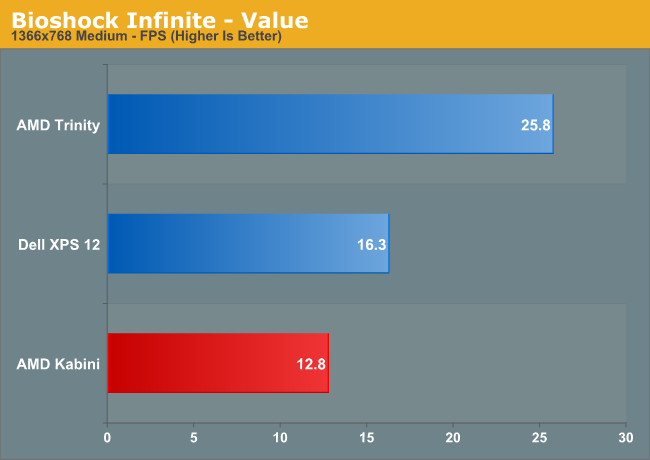

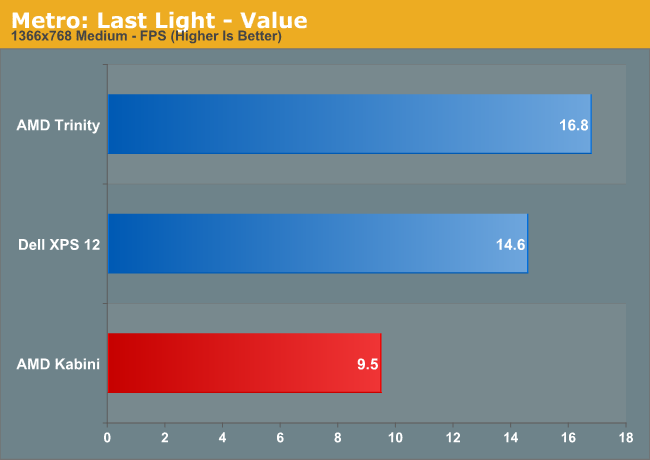
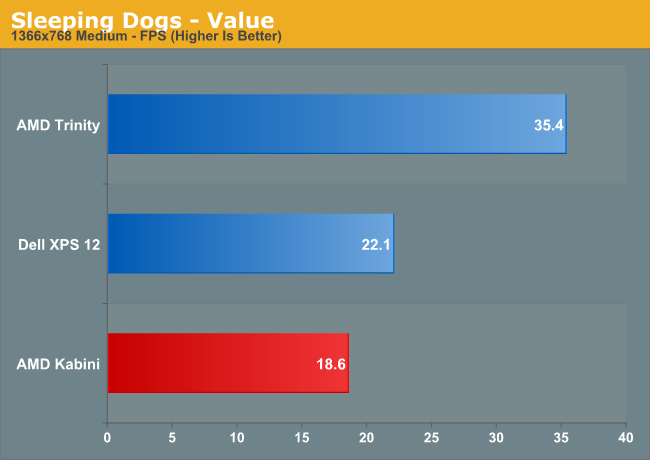
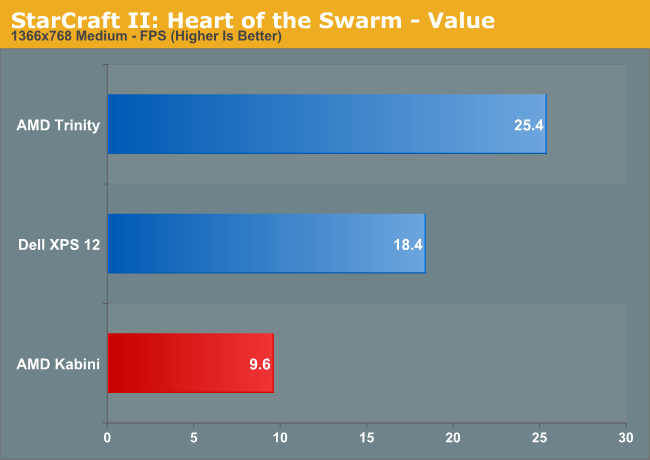
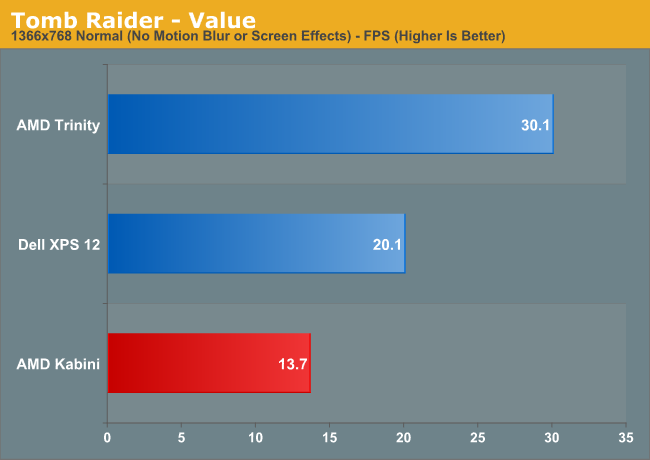
The short summary is that not a single game manages to crest the 30FPS mark, and I even ran additional tests at the minimum quality settings (at 1366x768) to see if I could improve the results. Sadly, I couldn’t, at least not enough to make the games playable; the best I managed was around 25 FPS in Bioshock, Skyrim, and Tomb Raider at minimum detail, and most titles remained in the sub-20 FPS range. Titles that tend to be more taxing on the CPU side of things like StarCraft II are even worse, with frame rates in StarCraft II being half of what IVB ULV gets at our Value (medium quality minus antialiasing) preset.
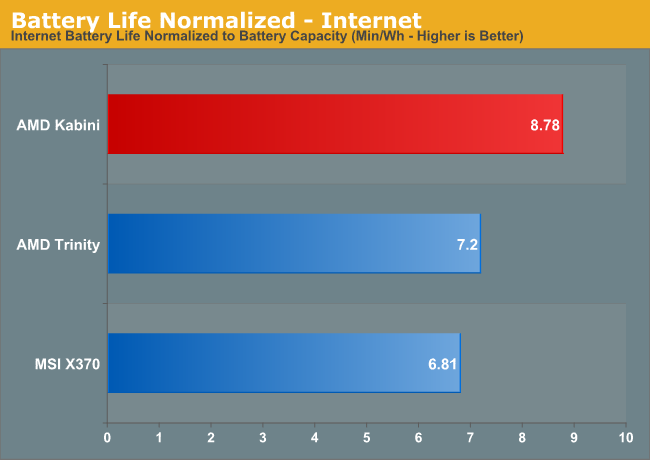
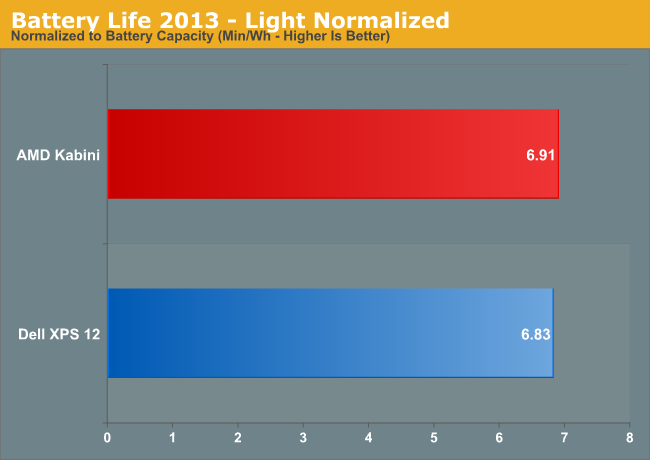
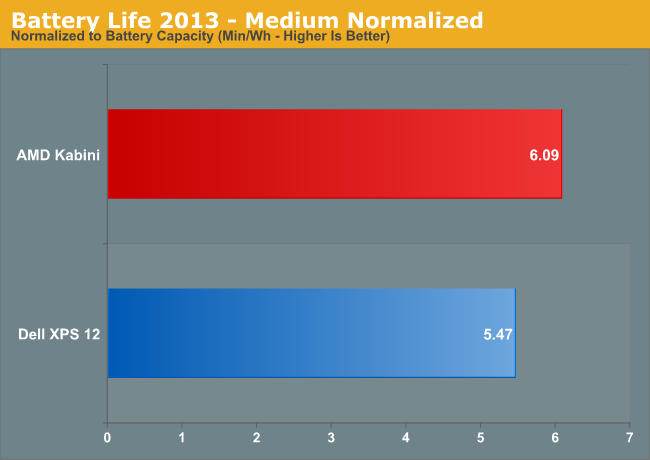
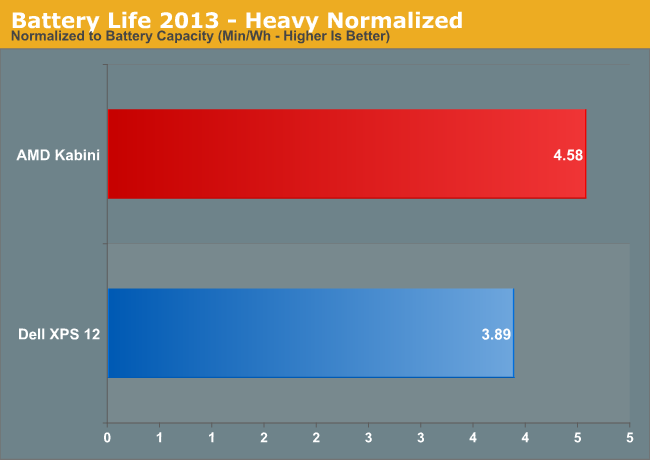
The good news is that not only is Kabini noticeably faster than Brazos, but it’s also mighty frugal when it comes to power use. We don’t have any Brazos laptops handy, so we had to use our older Internet battery life test as a comparison point (100 nits instead of 200 nits); in that test, Kabini topped 6.5 hours with a 45Wh battery. The MSI X370 we’re using as a comparison point did last a bit longer, but it also has a 64Wh battery. In terms of normalized power use, the Kabini laptop ends up being 29% more efficient, and that’s with a 14” AHVA 1080p panel going up against a 13.3” TN 768p display. We’re not quite able to compare apples to apples, but Kabini definitely looks like a good improvement over Brazos in power use.
The power story is even better when we look at ULV Ivy Bridge and standard Trinity APUs. Using our new battery life tests, which push the hardware a lot harder than our previous tests, Kabini delivers normalized battery life that’s at least equal to IVB ULV (our “Light” test), and in the more taxing Medium and Heavy tests Kabini beats ULV by 11% and 18%, respectively. Of course the IVB ULV system is still faster, and it’s also likely to cost twice what we expect Kabini laptops to sell for, but lower cost Celeron and Pentium ULV parts shouldn't be all that different. Also of note is that we don’t know yet how Haswell will fare in these same tests, but that’s an area Intel seems to be focusing on for their next CPU; that’s a story for next month….










130 Comments
View All Comments
Gigaplex - Thursday, May 23, 2013 - link
I don't think these chips are hUMA yet.silverblue - Saturday, May 25, 2013 - link
I don't think we're even getting that until Kaveri, unless the console setups feature it.HalloweenJack - Thursday, May 23, 2013 - link
why are you including a cpu which isn't in the same market? `hey here's a good AMD APU , but were going to ignore that and put an IB in the graphs for lol factor cause its far better and we don't want AMD to look good for once`. seriously anandtech.haukionkannel - Thursday, May 23, 2013 - link
This could be really nice in 7" to 8" windows8 tablet! Faster than atom, cheap and eat less power. Finally one can get surface pro tablet near 300-400$ and still get resonable good performance...Yeah Haswell ULV will be much faster, but then the cost will be near 1000$ for tablet, I am not so interested in that alternative!
Fanny how AMD can beat intel in ultra portable devices! We really need a new version of Atom to compete with this. Luckily it is coming so we will see some old fachioned competition in that sector! Competetion is good! We just have to see what has happened in highend CPU and see stalling situation in there...
whyso - Thursday, May 23, 2013 - link
This is using way more power than the atom z2760.Gaugamela - Thursday, May 23, 2013 - link
Go check benchmarks for Temash.whyso - Thursday, May 23, 2013 - link
Its still using about twice as much power.z2760 tdp is 1.7-3 watts.
axien86 - Thursday, May 23, 2013 - link
AMD Jaguars destroys Atom Z2760 in performance while costing the same. Consumers win.
silverblue - Saturday, May 25, 2013 - link
With Toms, they were told by AMD that Kabini should be compared to stuff within the same price bracket, hence the Pentium and i3 in their review.Here, AT doesn't have comparable hardware (they don't get sent it).
CajunArson - Thursday, May 23, 2013 - link
Dude.. AMD put together a laptop and shipped it to Anandtech for benchmarking. How is it Anandtech's fault that AMD intentionally chose not to put dual-channel memory into a prototype notebook that it built itself? Instead of blaming Anandtech for being "biased," maybe we should be looking at why AMD chose not to equip its own prototype with dual channel memory?